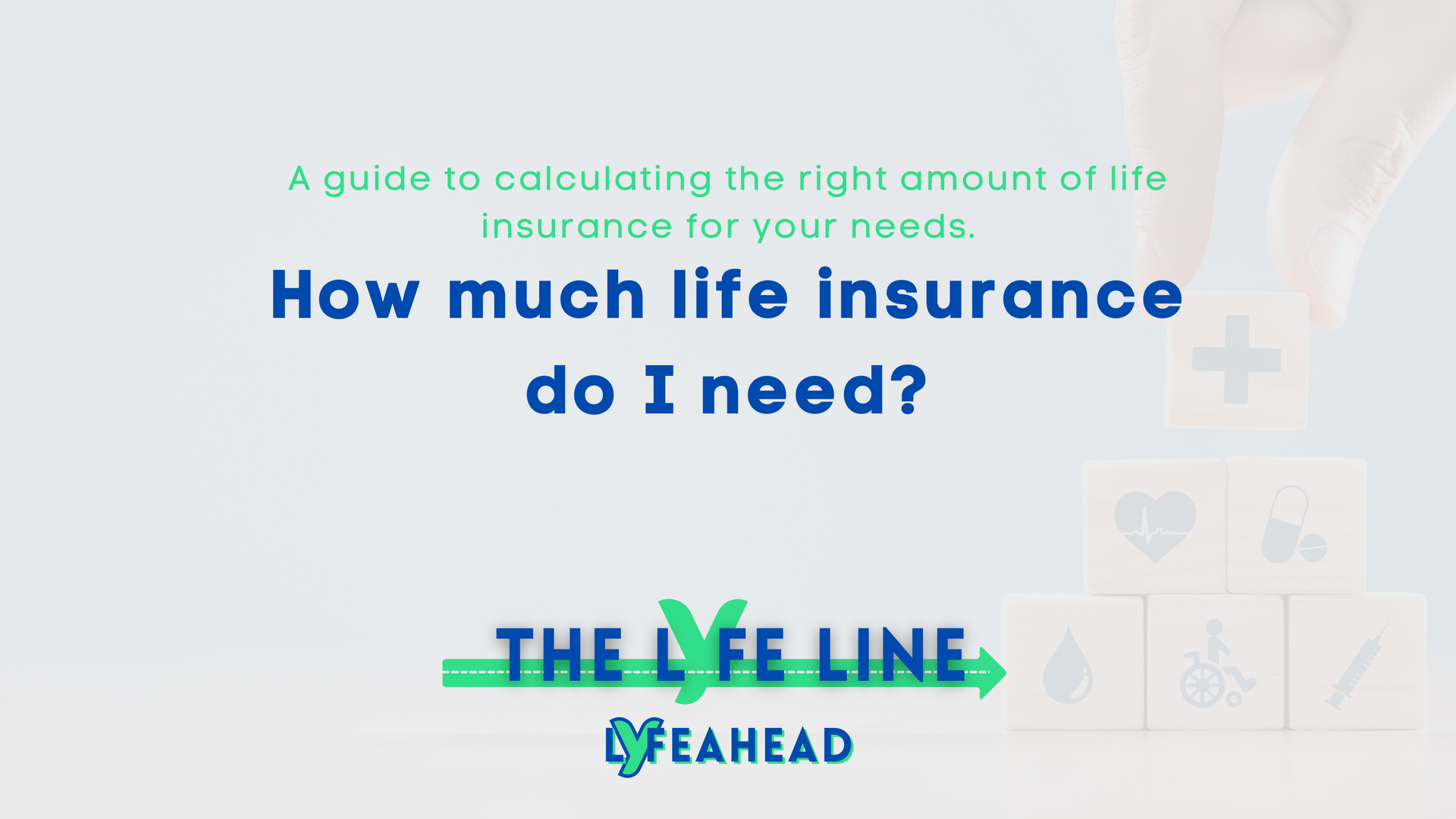LYFEAHEAD PRESENTS

Empowering You to Lead a Secured Life
The LYFE Line is your trusted source for timely and insightful information about life insurance, Medicare products, and beyond. Our articles are crafted with the goal of helping you navigate your way through the complexities of financial and health security. Whether you're just starting your journey or seeking to protect your future, The LYFE Line offers expert guidance, useful tips, and the latest industry news. Join us as we explore the various avenues of a secured life, because we believe that tomorrow matters today.
FEATURED ARTICLES

By Joe Hamilton
•
July 14, 2023
Medicare: An Essential Guide for Senior Healthcare Welcome back to The LYFE Line, brought to you by LYFEAHEAD Insurance. We’re your source of knowledge on all matters of insurance. In the previous articles, we've discussed the ins and outs of life insurance, and now, we're switching gears to talk about Medicare, the federal health insurance program for people who are 65 and older. Medicare is a U.S. government program that provides health insurance for Americans aged 65 and older, as well as for some younger people with certain disabilities or end-stage renal disease. Created in 1965, it's now an essential part of healthcare for millions of seniors and disabled Americans. Who is Eligible? To qualify for Medicare, there are generally two eligibility requirements: Age: You must be 65 or older, although certain younger individuals with disabilities or end-stage renal disease may also qualify. Citizenship: You must be a U.S. citizen, or a permanent legal resident for at least five continuous years. THE COVERAGES Medicare is divided into four parts, each covering different aspects of healthcare: Part A (Hospital Insurance) This is essentially coverage for inpatient care. It includes stays in the hospital, care in a skilled nursing facility, hospice care, and some types of home health care. Generally, if you've paid Medicare taxes for at least 10 years, you won't have to pay a monthly premium for Part A, though there are some deductibles and co-insurance costs. Part B (Medical Insurance) Part B covers certain doctor's visits and outpatient services, along with some preventive care (like screenings and vaccines). It also covers durable medical equipment, like wheelchairs or walkers, as well as mental health care, both inpatient and outpatient. Most people will need to pay a monthly premium for Part B. Part C (Medicare Advantage) Part C, also known as Medicare Advantage, is offered by private companies approved by Medicare. These plans include all the benefits and services covered under Part A and Part B, and usually Part D, prescription drug coverage. Most plans offer extra coverage for things like vision, hearing, dental, and health and wellness programs. Part D (Prescription Drug Coverage) Part D is prescription drug coverage and is offered by private companies approved by Medicare. It helps cover the cost of prescription medications and may help lower your prescription drug costs and protect against higher costs in the future. CONCLUSION It's important to remember that not all medical costs are covered by Medicare. Certain services and supplies may not be covered, and in most cases, you'll have to pay a deductible and a portion of the costs of your care. In our next article, we will dive deeper into Medicare Part A: Hospital Insurance. Remember, LYFEAHEAD Insurance isn’t just selling insurance policies - we are helping you navigate the 'Y's of insurance, so you're informed and empowered. Stay tuned for more from The LYFE Line.
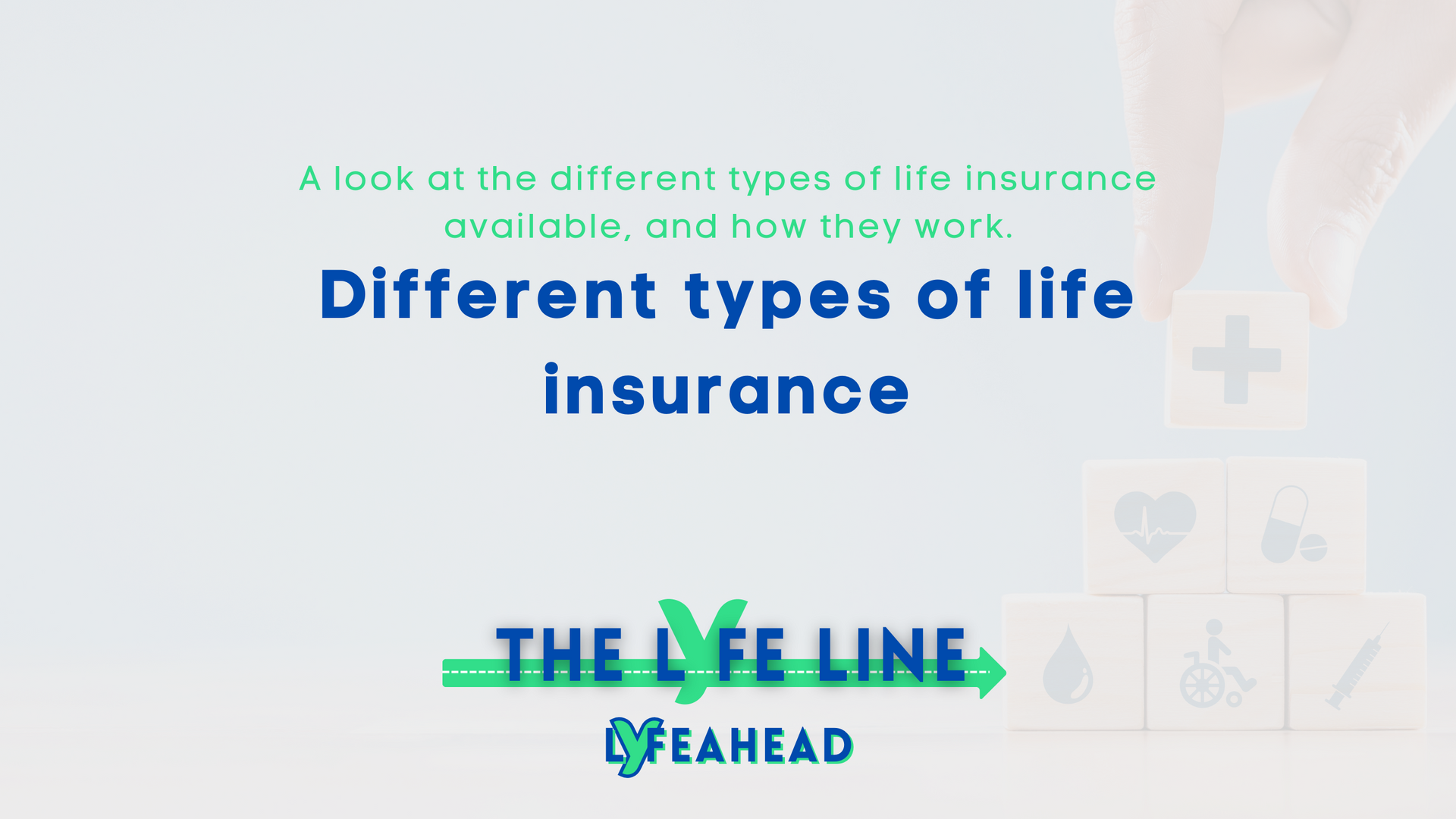
By Joe Hamilton
•
July 14, 2023
Life insurance plays a key role in protecting your loved ones' financial future. Yet, navigating the array of choices can feel overwhelming. We're here to help you unpack the different types of life insurance and their unique features. 1. Term Life Insurance: Simplicity and Affordability Term life insurance shines in its simplicity and affordability. With term life, you're covered for a set 'term' or period (e.g., 10, 20, or 30 years). If you pass away within this term, your beneficiaries receive a death benefit. If the term concludes while you're alive, coverage stops unless you renew the policy or purchase a new one. 2. Whole Life Insurance: Lifelong Coverage and Cash Value Whole life insurance is a permanent insurance offering lifelong coverage and a cash value component. This cash value grows over time, creating a potential source of loans. While premiums are typically higher than term life, they're consistent throughout your life. 3. Universal Life Insurance: Flexibility and Growth Universal life insurance is another form of permanent insurance that introduces greater flexibility. You can modify your premiums and death benefits within certain bounds. The policy's cash value is invested, meaning it could grow based on the performance of the investments. 4. Variable Life Insurance: Investment Opportunities Variable life insurance provides an avenue for policyholders to invest the policy's cash value. This type introduces potential for higher growth but also carries more risk compared to whole and universal life. The policy's death benefit and cash value can vary based on the performance of the investments. 5. Final Expense Insurance: Covering the Unforeseen Final expense insurance, also known as burial or funeral insurance, aims to cover the costs associated with your passing, like funeral expenses and medical bills. Typically a type of whole life insurance, it offers a small coverage amount. Conclusion: Choosing the right life insurance depends on a multitude of factors: your financial situation, life stage, long-term financial goals, and risk tolerance. At LYFE AHEAD, we recommend consulting with an insurance professional to make an informed decision. Please note that the specifics of these insurance products can differ among insurers. It's paramount to understand a policy fully before making a purchase.

July 14, 2023
When navigating the unpredictable journey of life, knowing that safeguards exist to protect us and our loved ones provides immense comfort. One such safeguard is life insurance, a crucial pillar of any sound financial plan. But what exactly is life insurance, and why does it matter so much? Let's dive in with The LYFE Line brought to you by LYFEAHEAD Insurance. Understanding Life Insurance In simple terms, life insurance is a contract between you and an insurance company. In this arrangement, you agree to pay regular premiums to the insurance company. In return, the company pledges to pay a specific sum, known as the death benefit, to your designated beneficiaries upon your demise. The Significance of Life Insurance Life insurance plays a pivotal role in cushioning the financial impact that could transpire upon the death of a primary earner. The death benefit from a life insurance policy can help offset funeral expenses, settle outstanding debts, fund educational pursuits, cover daily living costs, or even serve as an inheritance. Fundamentally, it provides peace of mind, ensuring your loved ones can maintain financial stability after you're gone. The Main Types of Life Insurance Life insurance can be broadly categorized into two types: term life and permanent life. Term life insurance is the most basic and typically the most cost-effective form of life insurance. You select a term (usually between 10 and 30 years), and if you pass away within that term, your beneficiaries receive the death benefit. Permanent life insurance , such as whole life or universal life, provides coverage for your entire life and includes a cash value component that grows over time. While these policies are generally pricier, they can be a vital part of your wider financial strategy. In Conclusion Life insurance is an indispensable financial tool, offering reassurance and financial resilience for your loved ones after you've passed away. The choice between term life or permanent life insurance will depend on your unique circumstances, goals, and budget. Seeking advice from a trusted insurance advisor can help steer you towards the right decision. The ideal time to purchase life insurance is when you're young and in good health, as premiums are generally more affordable then. However, it's never too late to explore your options and secure a stable future for yourself and your loved ones. Stay tuned for our next article on The LYFE Line, where we will delve into answering the important question: "How much life insurance do I need?" Make sure to follow LYFEAHEAD Insurance for more insightful discussions on life and Medicare insurance.
Life Insurance Articles

By Joe Hamilton
•
July 14, 2023
Hello, and welcome back to The LYFE Line! Brought to you by LYFEAHEAD Insurance, our series aims to provide you with comprehensive and easily understandable knowledge about life insurance. Today, we are discussing why life insurance is an essential financial product for everyone. WHY LIFE INSURANCE IS IMPORTANT Life insurance is an investment in peace of mind. While we can't predict the future, we can prepare for it. Here's why life insurance is vital: Financial Protection For Your Loved Ones Life insurance provides financial security to those who depend on your income, such as your spouse or children. In the event of your untimely death, the death benefit from the policy can help cover living expenses, debts, and future costs like education fees. Paying Off Debts and Final Expenses Without life insurance, your family may be responsible for paying your debts, such as mortgage or car loans, and your final expenses, including funeral and medical costs. A life insurance policy can prevent these financial burdens from falling onto your loved ones. Estate Planning Some life insurance policies can help manage inheritance issues by providing a death benefit that could cover estate taxes, thus ensuring that your heirs receive the full benefit of their inheritance. Saving For The Future Some life insurance policies, such as whole life or universal life insurance, have a cash value component that grows over time and can be borrowed against if needed. Charitable Contributions You can designate a charitable organization as the beneficiary of your life insurance policy, ensuring that your philanthropic goals continue to be met even after you're gone. CONCLUSION The importance of life insurance extends beyond these reasons. It's about leaving a financial legacy that provides for your loved ones when you're not there to do so. It's about the 'Y' in life insurance - 'Y' it matters to you and your loved ones. Stay tuned for our next installment of The LYFE Line where we demystify Medicare. Remember, LYFEAHEAD Insurance isn't just in the business of selling insurance policies; we are in the business of equipping you with the knowledge to make informed decisions about your financial future.
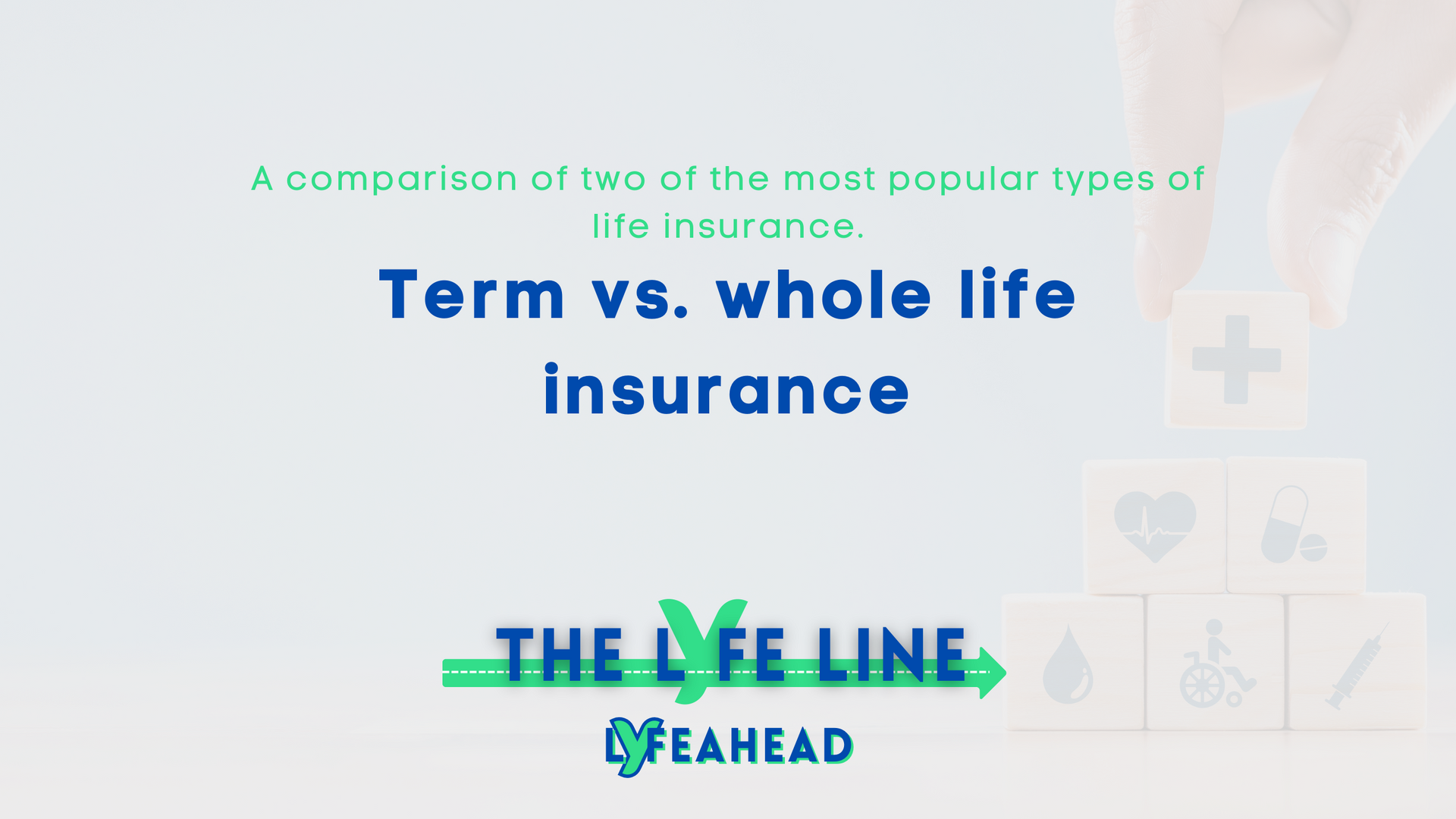
By Joe Hamilton
•
July 14, 2023
Welcome back to The LYFE Line, a series by LYFEAHEAD Insurance committed to empowering you with the knowledge to make informed decisions about life insurance. Today, we'll delve into a comparison of term and whole life insurance, two of the most commonly purchased life insurance products. Term Life Insurance Term life insurance is often hailed as the simplest form of life insurance. When you purchase a term life insurance policy, you're buying coverage for a specific term, typically 10, 20, or 30 years. If you pass away during the term, your beneficiaries will receive the policy's death benefit. Pros of Term Life Insurance: Affordability: It is generally less expensive than whole life insurance. Simplicity: It's straightforward with no investment component. Flexibility: You can choose the length of the term based on your needs. Cons of Term Life Insurance: Limited Coverage: If you outlive the term, your coverage ends. No Cash Value: It doesn't accumulate any cash value over time. Whole Life Insurance Whole life insurance, a type of permanent life insurance, provides lifelong coverage and accumulates cash value over time. The cash value grows at a guaranteed rate and can be borrowed against if needed. Pros of Whole Life Insurance: Lifelong Coverage: As long as premiums are paid, your beneficiaries are guaranteed a death benefit. Cash Value: It accumulates a cash value that grows over time. Fixed Premiums: Your premium amounts are fixed and won't increase over time. Cons of Whole Life Insurance: Cost: It is generally more expensive than term life insurance. Less Flexibility: The coverage amount, premiums, and cash value growth are all set and can't be adjusted. CONCLUSION When it comes to deciding between term and whole life insurance, there's no one-size-fits-all answer. It depends on your unique circumstances, financial goals, and life stage. An insurance professional can provide guidance and help you understand your options better. In our next article here at The LYFE Line, we'll provide a step-by-step guide on how to buy life insurance. Stay with us on this educational journey, and remember, at LYFEAHEAD Insurance, we're here to help you secure a safe and secure future for the ones you love most. Let us help you understand why life insurance isn't just a financial decision, it's a step towards a life of assurance.

By Joe Hamilton
•
July 14, 2023
Hello, and welcome back to The LYFE Line! As part of our educational series presented by LYFEAHEAD Insurance, we're committed to guiding you through various aspects of life insurance. Today, we dive into a step-by-step guide that will help you buy life insurance. THE SHOPPING PROCESS Step 1: Determine Your Needs Before purchasing life insurance, it's crucial to identify your needs. Who depends on your income? What financial obligations will they have if you are no longer there to provide? Your answers to these questions will help determine the kind of policy and coverage you need. Step 2: Select the Type of Life Insurance As we explored in our previous article, the primary types of life insurance are term life and whole life insurance. Term life insurance provides coverage for a specific term, while whole life insurance offers lifelong coverage along with a cash value component. Step 3: Decide on Coverage Amount Your coverage should adequately reflect your financial responsibilities. A common guideline is to have coverage that's 10 to 15 times your annual income. Don't forget to account for debts, mortgage payments, and future expenses like your children's education. Step 4: Get Quotes and Compare Policies With your insurance type and coverage amount in mind, it's time to shop around. Request quotes from different insurance providers, like us at LYFEAHEAD Insurance, and compare the coverage, premiums, policy terms, and the financial reliability of each insurer. Step 5: Apply for the Policy The application process usually involves a questionnaire about your health, lifestyle, and family medical history. You may also need to undergo a medical exam. Honesty is critical when filling out these forms. Step 6: Review and Activate Your Policy Upon approval of your application, you'll receive a policy to review. Ensure all the details are correct and as agreed. Your first premium payment will activate your policy. CONCLUSION Buying life insurance may seem complicated, but breaking it down into digestible steps makes the process manageable. The security that comes with knowing your loved ones will be financially protected is invaluable. Stay tuned for our next installment of The LYFE Line where we discuss the importance of life insurance. At LYFEAHEAD Insurance, we're dedicated to keeping you informed about your insurance options and providing you with suitable coverage options. We're not just selling policies; we're empowering our customers and emphasizing the 'Y' in life insurance.

By Joe Hamilton
•
July 14, 2023
Life insurance plays a key role in protecting your loved ones' financial future. Yet, navigating the array of choices can feel overwhelming. We're here to help you unpack the different types of life insurance and their unique features. 1. Term Life Insurance: Simplicity and Affordability Term life insurance shines in its simplicity and affordability. With term life, you're covered for a set 'term' or period (e.g., 10, 20, or 30 years). If you pass away within this term, your beneficiaries receive a death benefit. If the term concludes while you're alive, coverage stops unless you renew the policy or purchase a new one. 2. Whole Life Insurance: Lifelong Coverage and Cash Value Whole life insurance is a permanent insurance offering lifelong coverage and a cash value component. This cash value grows over time, creating a potential source of loans. While premiums are typically higher than term life, they're consistent throughout your life. 3. Universal Life Insurance: Flexibility and Growth Universal life insurance is another form of permanent insurance that introduces greater flexibility. You can modify your premiums and death benefits within certain bounds. The policy's cash value is invested, meaning it could grow based on the performance of the investments. 4. Variable Life Insurance: Investment Opportunities Variable life insurance provides an avenue for policyholders to invest the policy's cash value. This type introduces potential for higher growth but also carries more risk compared to whole and universal life. The policy's death benefit and cash value can vary based on the performance of the investments. 5. Final Expense Insurance: Covering the Unforeseen Final expense insurance, also known as burial or funeral insurance, aims to cover the costs associated with your passing, like funeral expenses and medical bills. Typically a type of whole life insurance, it offers a small coverage amount. Conclusion: Choosing the right life insurance depends on a multitude of factors: your financial situation, life stage, long-term financial goals, and risk tolerance. At LYFE AHEAD, we recommend consulting with an insurance professional to make an informed decision. Please note that the specifics of these insurance products can differ among insurers. It's paramount to understand a policy fully before making a purchase.

July 14, 2023
When navigating the unpredictable journey of life, knowing that safeguards exist to protect us and our loved ones provides immense comfort. One such safeguard is life insurance, a crucial pillar of any sound financial plan. But what exactly is life insurance, and why does it matter so much? Let's dive in with The LYFE Line brought to you by LYFEAHEAD Insurance. Understanding Life Insurance In simple terms, life insurance is a contract between you and an insurance company. In this arrangement, you agree to pay regular premiums to the insurance company. In return, the company pledges to pay a specific sum, known as the death benefit, to your designated beneficiaries upon your demise. The Significance of Life Insurance Life insurance plays a pivotal role in cushioning the financial impact that could transpire upon the death of a primary earner. The death benefit from a life insurance policy can help offset funeral expenses, settle outstanding debts, fund educational pursuits, cover daily living costs, or even serve as an inheritance. Fundamentally, it provides peace of mind, ensuring your loved ones can maintain financial stability after you're gone. The Main Types of Life Insurance Life insurance can be broadly categorized into two types: term life and permanent life. Term life insurance is the most basic and typically the most cost-effective form of life insurance. You select a term (usually between 10 and 30 years), and if you pass away within that term, your beneficiaries receive the death benefit. Permanent life insurance , such as whole life or universal life, provides coverage for your entire life and includes a cash value component that grows over time. While these policies are generally pricier, they can be a vital part of your wider financial strategy. In Conclusion Life insurance is an indispensable financial tool, offering reassurance and financial resilience for your loved ones after you've passed away. The choice between term life or permanent life insurance will depend on your unique circumstances, goals, and budget. Seeking advice from a trusted insurance advisor can help steer you towards the right decision. The ideal time to purchase life insurance is when you're young and in good health, as premiums are generally more affordable then. However, it's never too late to explore your options and secure a stable future for yourself and your loved ones. Stay tuned for our next article on The LYFE Line, where we will delve into answering the important question: "How much life insurance do I need?" Make sure to follow LYFEAHEAD Insurance for more insightful discussions on life and Medicare insurance.
Medicare Articles
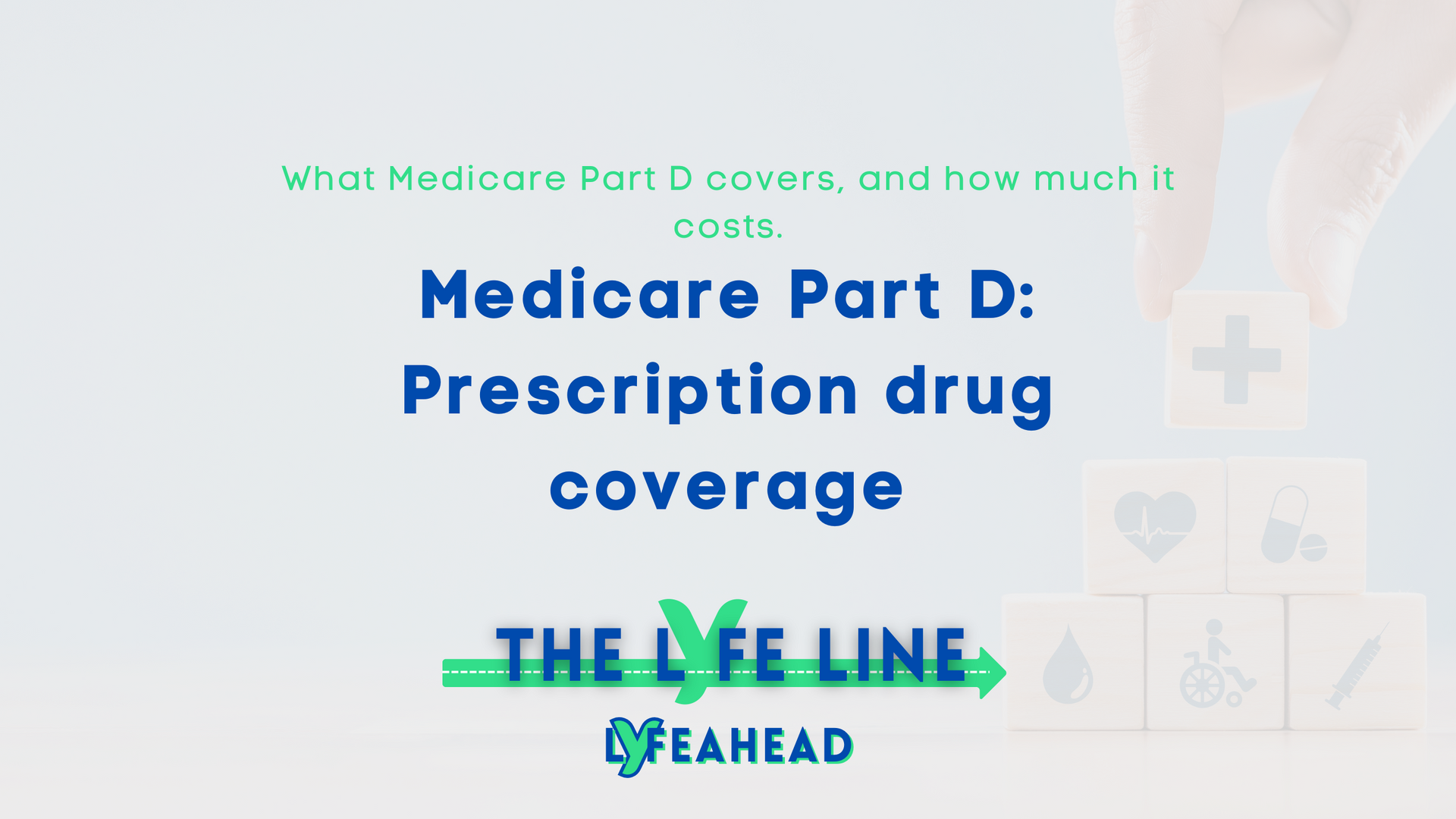
By The LYFE Line
•
July 22, 2023
Medicare Part D: Prescription Drug Coverage What Medicare Part D covers, and how much it costs Medicare Part D provides prescription drug coverage to help seniors pay for medications. This article from LYFEAHEAD Insurance explains what Part D includes, what it costs, and how to enroll. What Does Medicare Part D Cover? Original Medicare does not include prescription drug coverage. To get this benefit, you must enroll in a standalone Part D plan or a Medicare Advantage plan that bundles Part D. These plans are offered by private insurers approved by Medicare. Part D helps pay for both brand name and generic prescription medications at participating pharmacies. It covers drugs across a broad formulary or list of covered medications. However, some specific drugs may not be included. How Much Does Part D Cost? Plans group covered drugs into different "tiers" based on cost. You will pay a copay or coinsurance percentage for each prescription filled. Copays are higher for more expensive, non-preferred brands. Part D has an annual deductible you must meet before coverage kicks in. For 2023, the standard deductible is $505. After reaching this amount out-of-pocket, you'll pay 25% coinsurance until reaching the initial coverage limit ($4,660 in 2023). Beyond this limit is a coverage gap where you pay more, followed by catastrophic coverage with reduced costs. Part D policies have a monthly premium, which varies by plan. Higher income seniors pay an additional premium amount based on income brackets. Enrolling in Medicare Part D You can sign up for Part D during your Initial Enrollment Period when you first turn 65, or each year during Medicare's Annual Enrollment Period from October 15 to December 7. Missing enrollment deadlines can result in lifelong late penalties added to your premium. Conclusion: LYFEAHEAD Insurance helps simplify Medicare and Part D choices. Our licensed agents explain plan options, benefits and costs. We provide personalized recommendations to meet your prescription needs and budget. Contact us at www.lyfeahead.com to make sure your medications are covered.
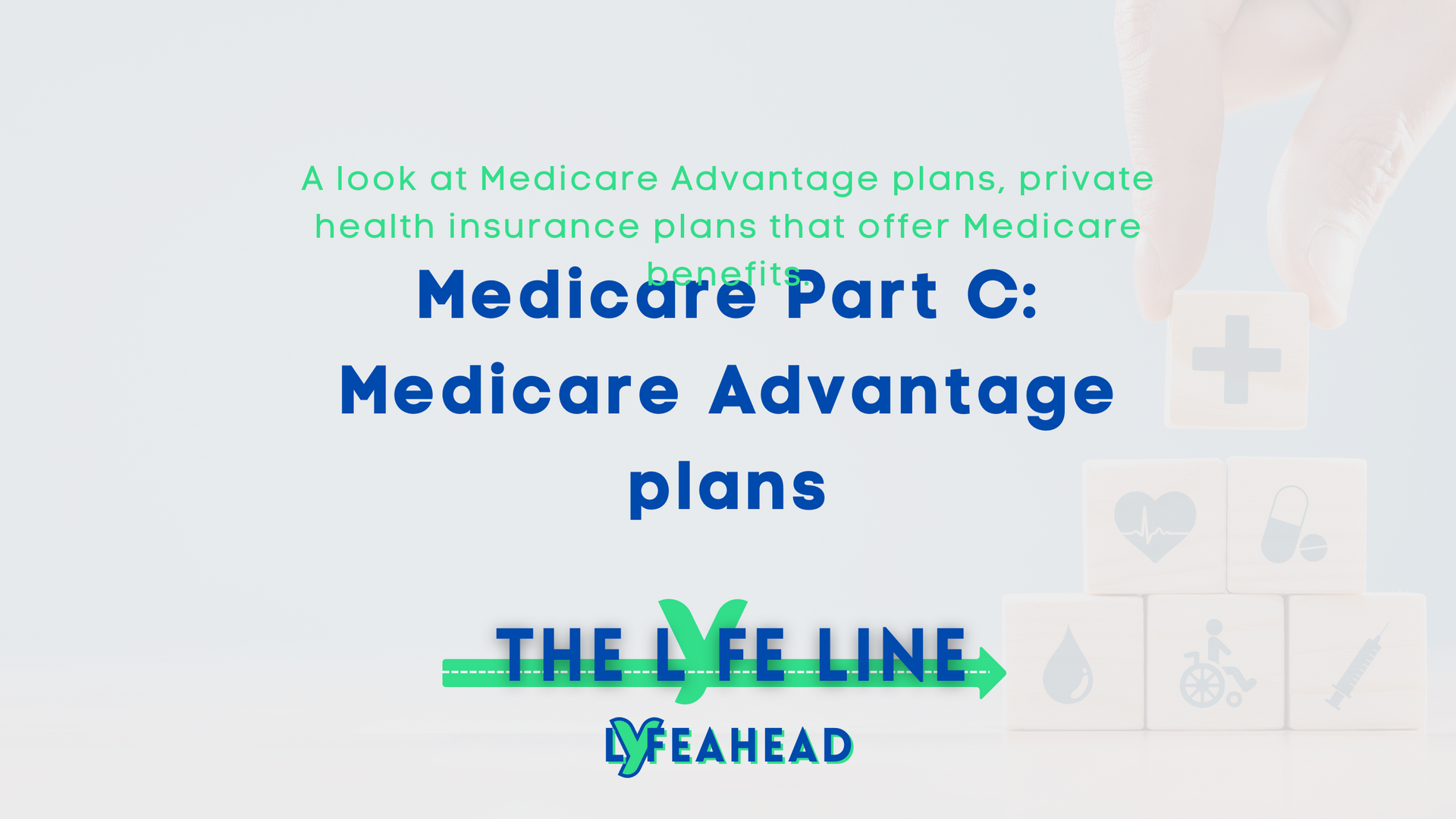
By Joe Hamilton
•
July 14, 2023
Navigating Medicare Part C: Medicare Advantage Plans Welcome back to The LYFE Line, your trusted resource brought to you by LYFEAHEAD Insurance, where we're navigating the 'Y's of insurance together. Today, we'll be delving into Medicare Part C, also known as Medicare Advantage plans. Medicare Part C, or Medicare Advantage, offers a different route to get your Medicare benefits. These plans are offered by private insurance companies approved by Medicare. They include everything Medicare Part A (Hospital Insurance) and Part B (Medical Insurance) cover, and often provide extra benefits. Extra Benefits Many Medicare Advantage plans offer prescription drug coverage (Part D), and some may offer additional benefits that Original Medicare doesn’t cover, such as vision care, hearing aids, dental care, wellness programs, and even gym memberships. Different Types of Medicare Advantage Plans There are several different types of Medicare Advantage plans, including: Health Maintenance Organization (HMO) Plans : In most HMOs, you can only go to doctors, specialists, or hospitals on the plan's list except in an emergency. You may also need to get a referral from your primary care doctor to see a specialist. Preferred Provider Organization (PPO) Plans : In a PPO, you pay less if you use doctors, hospitals, and other healthcare providers that belong to the plan's network. You can use doctors, hospitals, and providers outside of the network for an additional cost. Private Fee-for-Service (PFFS) Plans : PFFS plans are similar to Original Medicare in that you can generally go to any doctor or hospital you could go to under Original Medicare, provided they accept the plan’s payment terms. Special Needs Plans (SNPs) : SNPs provide focused and specialized healthcare for specific groups of people, like those who have both Medicare and Medicaid, live in a nursing home, or have certain chronic medical conditions. Costs The cost for a Medicare Advantage Plan varies and depends on several factors, including whether the plan charges a monthly premium in addition to your Part B premium, what it charges for services like hospital visits or prescription drugs, and the plan’s yearly limit on your out-of-pocket costs. CONCLUSION Medicare Advantage Plans represent a way to potentially get more from your Medicare coverage, but it's essential to review each plan carefully to ensure it aligns with your healthcare needs and budget. Stay tuned to The LYFE Line for our next article where we'll take a closer look at Medicare Part D: Prescription Drug Coverage. As always, LYFEAHEAD Insurance is here to guide you through the 'Y's of your insurance decisions.
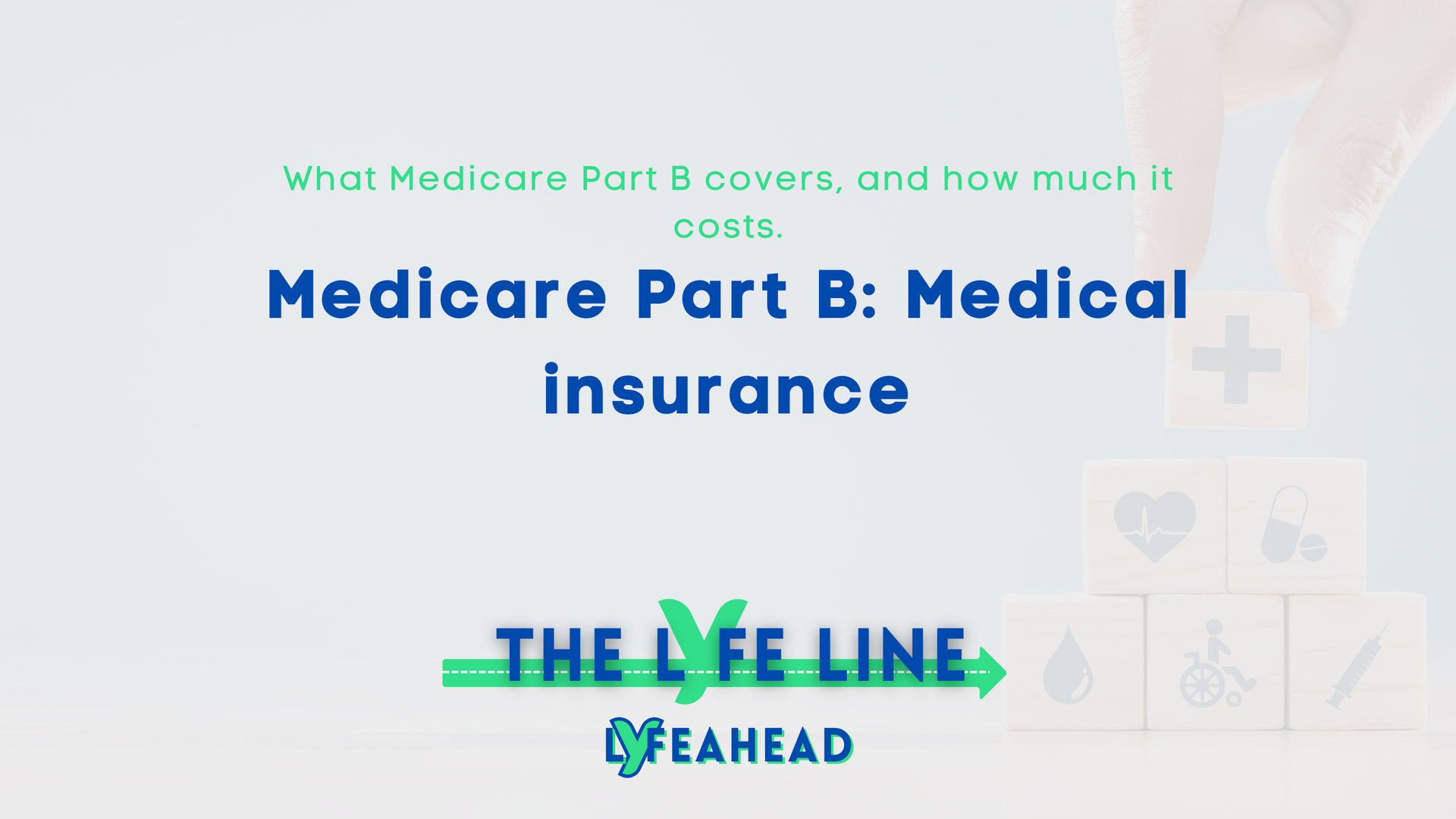
By Joe Hamilton
•
July 14, 2023
Unraveling Medicare Part B: Medical Insurance Welcome back to The LYFE Line, your go-to resource by LYFEAHEAD Insurance, where we break down the 'Y's of insurance. In our previous articles, we have been delving into the various parts of Medicare. Today, we continue that journey with a deep dive into Medicare Part B: Medical Insurance. Medicare Part B is often referred to as medical insurance because it covers the costs of medically necessary and preventative services. Here's a closer look at what Part B covers: Doctor and Specialist Services Part B covers the services that you receive from your doctors, including specialists. This includes appointments at their offices, services you receive in a hospital, and telehealth services. Outpatient Services This includes outpatient care you receive in a hospital, including partial hospitalization mental health care, and outpatient surgery. Preventive Services Medicare Part B also covers a variety of preventive services to keep you healthy. These can include cardiovascular screenings, flu shots, diabetes screenings, and more. Home Health Services Under certain conditions, Part B will cover part-time or intermittent skilled care, physical therapy, speech-language pathology services, continued occupational services, and more. Durable Medical Equipment Durable medical equipment (DME), like wheelchairs, walkers, and oxygen equipment, is covered under Part B if your doctor deems it medically necessary. Mental Health Services Medicare Part B covers mental health services, including yearly depression screenings, visits with a psychiatrist or other doctor, individual and group psychotherapy, and more. Prescription Drugs Part B covers a limited number of prescription drugs under certain circumstances, such as drugs used with an item of durable medical equipment, like an infusion pump or drugs given to you by a doctor during an office visit. CONCLUSION Unlike Medicare Part A, Part B does require a monthly premium, which is typically deducted from your Social Security, Railroad Retirement, or Civil Service Retirement payment. The cost may vary based on your income. Remember, LYFEAHEAD Insurance is here to guide you through the 'Y's of your healthcare decisions, ensuring you get the coverage that best suits your needs. Join us next time on The LYFE Line as we explore Medicare Part C: Medicare Advantage Plans.
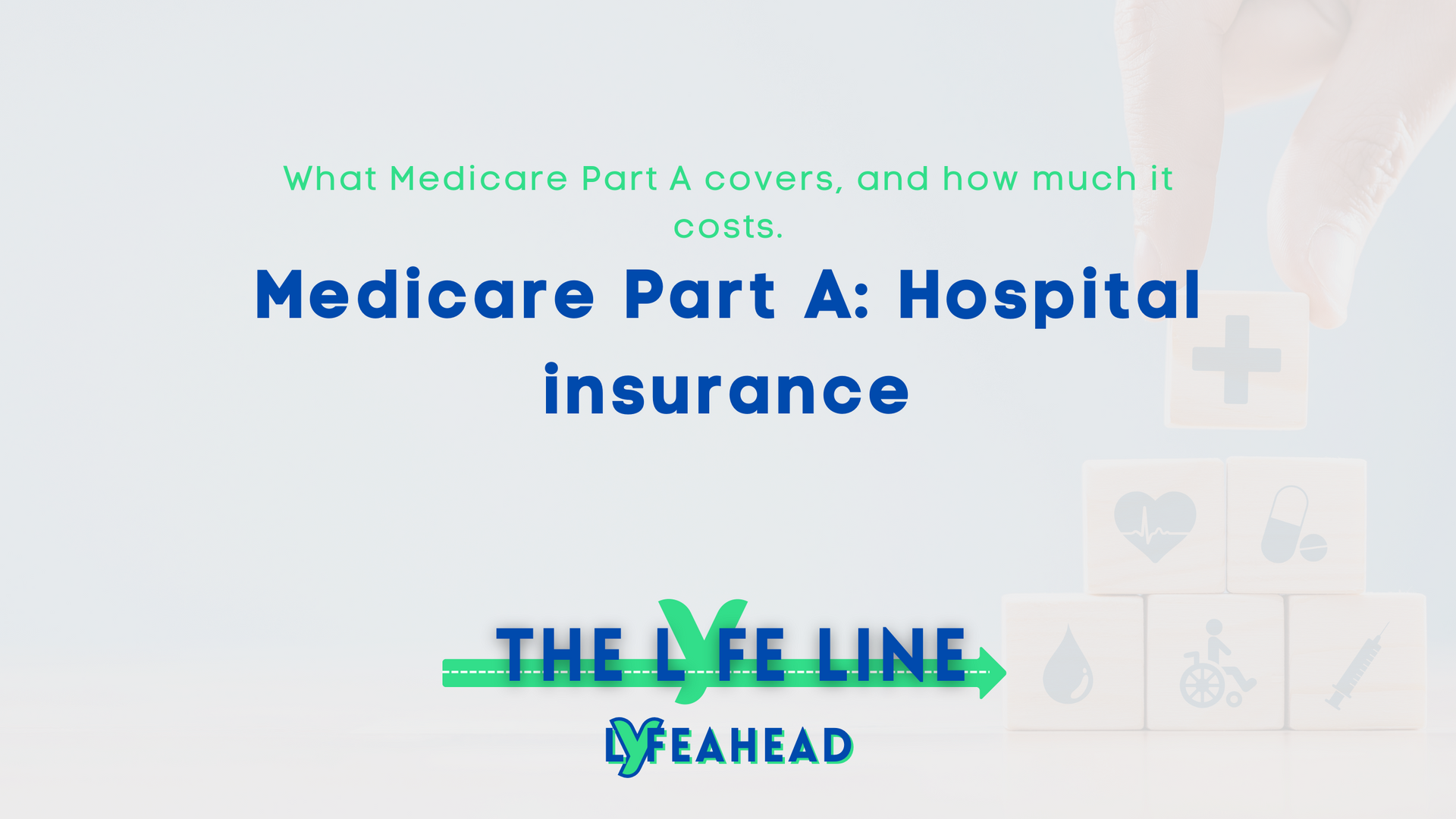
By Joe Hamilton
•
July 14, 2023
UNDERSTANDING MEDICARE: PART A Welcome back to The LYFE Line, presented by LYFEAHEAD Insurance, your guide through the 'Y's of insurance. In the last piece, we began our exploration of Medicare with an overview of its different parts. Today, we will delve into the details of Medicare Part A: Hospital Insurance. Medicare Part A covers inpatient hospital stays, care in a skilled nursing facility, hospice care, and some types of home health care. Let's break these down: Inpatient Hospital Stays Part A coverage includes your room, meals, nursing services, and any other services and supplies that the hospital provides. It does not cover private-duty nursing, a television, or a phone in your room. You'll also have to pay a deductible for each benefit period. Skilled Nursing Facility Care Following a hospital stay of at least three days, Medicare Part A will cover a stay in a skilled nursing facility for needed daily skilled care like intravenous injections or physical therapy. Keep in mind that Medicare does not cover long-term or custodial care. Hospice Care If a doctor certifies that you're terminally ill and are expected to have six months or less to live, Medicare Part A can cover hospice care. It includes pain relief, symptom control, and support services. Home Health Care In certain situations, Part A will cover health care in your own home, including physical therapy, occupational therapy, speech-language pathology, and part-time skilled nursing care. To be covered, you must be homebound and under the care of a doctor. Generally, if you or your spouse paid Medicare taxes for at least 40 quarters (10 years), you won't have to pay a monthly premium for Part A, though there are some deductibles and co-insurance costs. CONCLUSION Medicare Part A can be a lifesaver for those needing hospital care or skilled nursing care after a hospital stay. However, it's important to remember that not everything is covered. That's where LYFEAHEAD Insurance comes in. We are here to help you understand the 'Y's of insurance, assisting you to make the best decisions for your healthcare future. Next time on The LYFE Line, we will be discussing Medicare Part B: Medical Insurance. Stay tuned!

By Joe Hamilton
•
July 14, 2023
Medicare: An Essential Guide for Senior Healthcare Welcome back to The LYFE Line, brought to you by LYFEAHEAD Insurance. We’re your source of knowledge on all matters of insurance. In the previous articles, we've discussed the ins and outs of life insurance, and now, we're switching gears to talk about Medicare, the federal health insurance program for people who are 65 and older. Medicare is a U.S. government program that provides health insurance for Americans aged 65 and older, as well as for some younger people with certain disabilities or end-stage renal disease. Created in 1965, it's now an essential part of healthcare for millions of seniors and disabled Americans. Who is Eligible? To qualify for Medicare, there are generally two eligibility requirements: Age: You must be 65 or older, although certain younger individuals with disabilities or end-stage renal disease may also qualify. Citizenship: You must be a U.S. citizen, or a permanent legal resident for at least five continuous years. THE COVERAGES Medicare is divided into four parts, each covering different aspects of healthcare: Part A (Hospital Insurance) This is essentially coverage for inpatient care. It includes stays in the hospital, care in a skilled nursing facility, hospice care, and some types of home health care. Generally, if you've paid Medicare taxes for at least 10 years, you won't have to pay a monthly premium for Part A, though there are some deductibles and co-insurance costs. Part B (Medical Insurance) Part B covers certain doctor's visits and outpatient services, along with some preventive care (like screenings and vaccines). It also covers durable medical equipment, like wheelchairs or walkers, as well as mental health care, both inpatient and outpatient. Most people will need to pay a monthly premium for Part B. Part C (Medicare Advantage) Part C, also known as Medicare Advantage, is offered by private companies approved by Medicare. These plans include all the benefits and services covered under Part A and Part B, and usually Part D, prescription drug coverage. Most plans offer extra coverage for things like vision, hearing, dental, and health and wellness programs. Part D (Prescription Drug Coverage) Part D is prescription drug coverage and is offered by private companies approved by Medicare. It helps cover the cost of prescription medications and may help lower your prescription drug costs and protect against higher costs in the future. CONCLUSION It's important to remember that not all medical costs are covered by Medicare. Certain services and supplies may not be covered, and in most cases, you'll have to pay a deductible and a portion of the costs of your care. In our next article, we will dive deeper into Medicare Part A: Hospital Insurance. Remember, LYFEAHEAD Insurance isn’t just selling insurance policies - we are helping you navigate the 'Y's of insurance, so you're informed and empowered. Stay tuned for more from The LYFE Line.
Sign up for important updates and announcements.
Sign up to receive news and updates from our team.
Contact Us
Thank you for contacting us.
We will get back to you as soon as possible.
We will get back to you as soon as possible.
Oops, there was an error sending your message.
Please try again later.
Please try again later.
Start feeling at ease.
Join us today.
Join LYFEAHEAD Insurance to put yourself and your family in a financially safe place now, and in the future.
Insurance
Company
© 2025
All Rights Reserved | LYFEAHEAD Insurance, LLC
